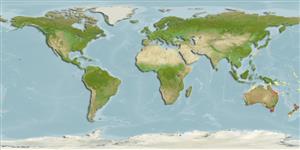Environment: milieu / climate zone / depth range / distribution range
Ecologia
marinhas associadas(os) a recifes; intervalo de profundidade 0 - 10 m (Ref. 57886). Temperate
Southwest Pacific: Australia and New Zealand.
Tamanho / Peso / Idade
Maturity: Lm ? range ? - ? cm
Max length : 10.0 cm TL macho/indeterminado; (Ref. 30464); 7.3 cm SL (female); common length : 8.0 cm TL macho/indeterminado; (Ref. 30464)
A common, secretive species of inshore reefs (Ref. 34024). Lives on rocky shores, often buried in sand, mud or silt below stones or other hard substrate. Specimens in collections often had medium to coarse grained quartz sand trapped in the gill opening (a sand-bottom adaptation and might explain why it is so rarely caught together with D. hoesei, even though both species live in the same general area of south-eastern Australia Depths down to 5 m. A female specimen (AMS I.16469-016, 62 mm SL ) was found to contain two pale unpigmented embryos, 6-7 mm SL. Maximum length for female taken from Ref. 57886.
Ciclo de vida ou comportamento de acasalamento
Maturidade | Reprodução | Desova | Ovos | Fecundidade | Larvas
Møller, P.R. and W. Schwarzhans, 2006. Review of the Dinematichthyini (Teleostei, Bythitidae) of the Indo-west Pacific, Part II. Dermatopsis, Dermatopsoides and Dipulus with description of six new species. The Beagle 22:39-76. (Ref. 57886)
Status na Lista Vermelha da UICN (Ref. 130435: Version 2024-2)
Ameaça para os humanos
Harmless
Uso pelos humanos
Pescarias: sem interesse
Ferramentas
Relatórios especiais
Baixar XML
Fontes da internet
Estimates based on models
Preferred temperature (Ref.
123201): 15.3 - 27.2, mean 23.3 °C (based on 731 cells).
Índice de diversidade filogenética (Ref.
82804): PD
50 = 0.5312 [Uniqueness, from 0.5 = low to 2.0 = high].
Bayesian length-weight: a=0.00389 (0.00180 - 0.00842), b=3.12 (2.94 - 3.30), in cm total length, based on all LWR estimates for this body shape (Ref.
93245).
Nível Trófico (Ref.
69278): 3.3 ±0.5 se; based on size and trophs of closest relatives
Resiliência (Ref.
120179): Baixo, tempo mínimo de duplicação da população 4,5 - 14 anos (Assuming Fec < 100).
Fishing Vulnerability (Ref.
59153): Low vulnerability (10 of 100).
